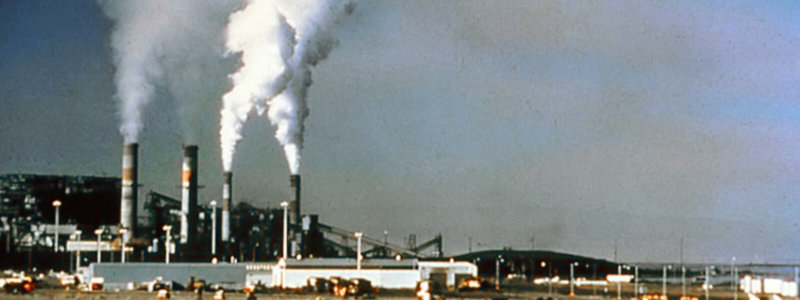Article: Why We Become Oxygen Deficient
Also, check out our
companion video:
What is Oxygen Deficiency and How Do We Become Oxygen Deficient?
Your body has many ways of showing you may be suffering from an oxygen deficiency. Some symptoms may include bronchial problems, acid stomach, irritability, irrational behavior, memory loss, depression, dizziness, muscle aches and pains, poor digestion, circulation problems, fatigue, and overall body weakness. You should see your doctor immediately if you have any of these symptoms.
Also, consider what happens when your immune system suffers from a lack of oxygen. Your body has to work much harder to combat opportunistic bacteria, parasitic infections, and colds as well as flu.
It’s interesting to know that cancer and most other diseases cannot live in an oxygen-rich environment. Dr. Otto Warburg, a Nobel laureate in cancer research has stated,
Cancer has only one prime cause. It is the replacement of normal oxygen respiration of the body’s cells by an anaerobic (i.e., oxygen deficient) cell respiration.
Cancer has only one prime cause. It is the replacement of normal oxygen respiration of the body’s cells by an anaerobic (i.e., oxygen deficient) cell respiration.
— Warburg, Otto, Dr., The Prime Cause and Prevention of Cancer. The Lindau Lecture, Germany, Wurzburg, Germany: K. Trilsch. 1966.
If you haven’t thought about the importance of correct oxygen levels before, look at some of the labels the medical community puts on this problem.
An inadequate supply of oxygen is called hypoxia and falls into the following categories:
- Anemic hypoxia: Arterial oxygen pressure is normal, but the total oxygen content of the blood is reduced.
- Cerebral hypoxia: Decreased oxygen supply to the brain even though there is adequate blood flow. Brain cells can die within five minutes of oxygen deficiency.
- Generalized hypoxia: Occurs in healthy people ascending to high altitudes, or diving underwater where closed-circuit re-breather systems fail to control the amount of oxygen in the air.
- Histotoxic hypoxia: The inability of the tissues to use oxygen, such as carbon monoxide and cyanide poisoning. This also happens when using certain narcotics, tobacco, and alcohol.
- Hypemic hypoxia: The reduction in the blood’s oxygen-carrying capacity, such as low amounts of hemoglobin in the red blood cells. This can be caused by blood donation, hemorrhage, anemia, chemicals, carbon monoxide, or smoking.
- Hypoxic hypoxia: Low amounts of oxygen passing into the blood. This can be caused by low oxygen pressure in the lungs, small gas exchange areas, high altitude, or lung disease.
- Stagnant hypoxia: Poor circulation of the blood or poor blood flow.
- Anoxia: When there is a complete absence of oxygen in tissues. Metabolism is disrupted and cells die in minutes. When someone “turns blue,” it’s a sign of severe hypoxia.
By now, I hope you’re convinced about the need for correct oxygen levels. Does that mean if we need more oxygen, we should just breathe harder or more often? Unfortunately, that won’t help. That’s because the two leading causes of oxygen deficiency are the quality of the air we breathe, and the choice of foods the average person includes in his diet. So, what’s the solution?
Air Quality and Diet
Consider air quality. The amount of oxygen in the air available to us has diminished over the years, especially in cities and industrial areas where air pollution and carbon monoxide contribute to this process. For instance, air samples found in bubbles in ancient fossilized amber contained oxygen levels of 38%. By the 1900s, oxygen content had diminished to 24%. Today, oxygen content has dropped to 19 to 21% in large cities. It may be as little as 15%. The earth cannot support human life if oxygen content drops to 7%. We are in serious trouble but that is not the only threat.

The air that we are breathing is filled with dust, pollen, tar, acid, smoke, bacteria, rubber, carbon, and metals. Another environmental tragedy is the destruction of ocean plankton and rainforest vegetation which are the world’s leading sources of oxygen.
While we are talking about pollution, let’s address how we are polluting ourselves every day through our diet and choices of food. How many processed foods do you eat during the day? Well, processed foods are characterized by being low in fiber, enzymes, water, and oxygen content, while being high in saturated fats and sugars. Because of the low oxygen content in processed foods, our body must take oxygen from other needs to process this oxygen-deficient food. When this food is not metabolized correctly, it leaves an accumulation of toxins that haven’t been burned because of a lack of oxygen.
More Reasons Why We Become Oxygen Deficient
We’ve all heard about the evils of saturated fats. When we can not thoroughly burn saturated fats because of a lack of oxygen, our body stores them as fat in our arteries and on our hips, thighs, and stomach. More fat means more oxygen deficiency.
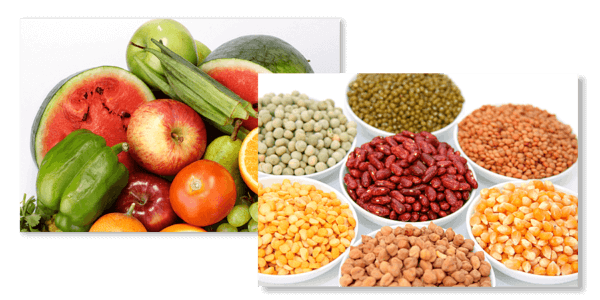
Even our body chemistry is affected by low levels of oxygen. Our body is constantly searching for the right balance between an acid and alkaline chemistry. Our oxygen reserves are strained when we consume too many acid-forming foods (such as carbonated soft drinks, coffee, meat, and dairy products). During this process, the body attempts to neutralize excess acidity and remove lactic acid, a toxic byproduct. We can only perform at 5 to 10% of our oxygen-carrying capacity when our bodies are in an acidic environment.
To sum up, we become oxygen deficient because the amount of oxygen available in our air has diminished, our environment has become polluted, and our processed food diets create an acidic condition that hurts our bodies. The solution is to make more sources of oxygen available to our bodies, and one way is to use bio-available liquid oxygen like OxygenSuperCharger™.
Our OxygenSuperCharger™ is the world's premiere bio-available liquid oxygen supplement.
-
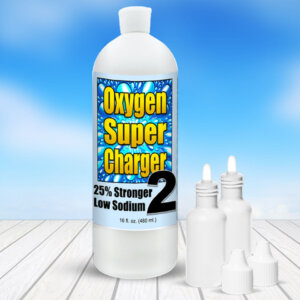
Ultra Strength OxygenSuperCharger2, 25% Stronger, 16–Ounce Bottle
$119.97 Add to cart -
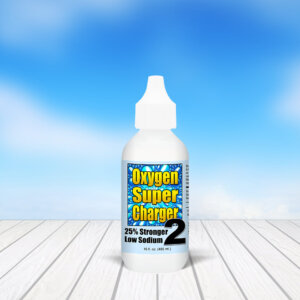
Ultra Strength OxygenSuperCharger2, 25% Stronger, 2–Ounce (Sample Size)
$35.97 Add to cart -
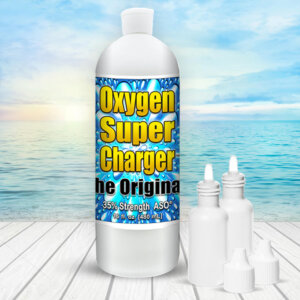
Original 35% Strength OxygenSuperCharger, 16–Ounce Bottle
$96.97 Add to cart -
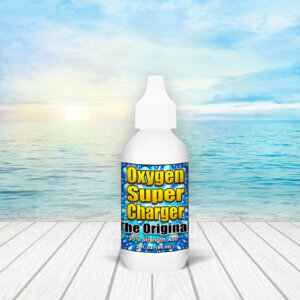
Original 35% Strength OxygenSuperCharger, 2–Ounce (Sample Size)
$27.97 Add to cart




